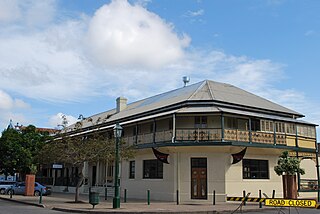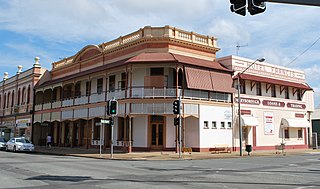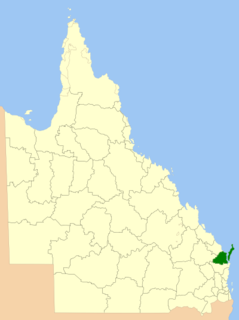
Maryborough Courthouse is a heritage-listed courthouse at 170 Richmond Street, Maryborough, Fraser Coast Region, Queensland, Australia. It was designed by Francis Drummond Greville Stanley and built in 1877 by John Thomas Annear for the Queensland Government. It is also known as Maryborough Court House and Government Offices. It was added to the Queensland Heritage Register on 21 October 1992.

Maryborough Central State School is a heritage-listed state school at 471 Kent Street, Maryborough, Fraser Coast Region, Queensland, Australia. It was built from 1875 to 1953. It is also known as Central State School for Boys, Central State School for Girls, and Central State School for Infants. It was the first state school in Maryborough and was established with separate girls and boys departments. It is the oldest public school in Queensland. It was added to the Queensland Heritage Register on 31 October 1994.

Customs House Hotel is a heritage-listed hotel at 116 Wharf Street, Maryborough, Fraser Coast Region, Queensland, Australia. It was built in 1868. It was added to the Queensland Heritage Register on 21 October 1992.

Royal Hotel is a heritage-listed hotel on the corner of Kent Street and Bazaar Street, Maryborough, Fraser Coast Region, Queensland, Australia. It was designed by Eaton & Bates and built from 1892 to 1930s. It was added to the Queensland Heritage Register on 21 October 1992.

Exchange Hotel is a heritage-listed hotel at 134-138 Patrick Street, Laidley, Lockyer Valley Region, Queensland, Australia. It was designed by Eaton & Bates and built in 1902. It was added to the Queensland Heritage Register on 21 October 1992.

Pollock's Shop House is a heritage-listed general store at 617-619 Stanley Street, Woolloongabba, City of Brisbane, Queensland, Australia. It was built c. 1865. It was added to the Queensland Heritage Register on 21 October 1992.

National Hotel is a heritage-listed hotel at 35 Grafton Street, Warwick, Southern Downs Region, Queensland, Australia. It was designed by James Marks and Son built in 1907 by Daniel Connolly. It is also known as Allman's Hotel. It was added to the Queensland Heritage Register on 21 October 1992.

Gympie Lands Office is a heritage-listed former court house and public administration building at 26 Channon Street, Gympie, Queensland, Australia. It was designed by Queensland Department of Public Works and Queensland Colonial Architect's Office and built in 1942 by the Department of Public Works, Gympie City Council, Mark Doggett, Andrew Collins, and George Caldwell. It was added to the Queensland Heritage Register on 15 July 2011.

Australian Joint Stock Bank Building is a heritage-listed former bank and now commercial building at 331 Kent Street, Maryborough, Fraser Coast Region, Queensland, Australia. It was designed by Francis Drummond Greville Stanley and built in 1882 by French & Crystall. It is also known as Department of Primary Industries Building, Union Bank, and the Office of Sport and Recreation. It was added to the Queensland Heritage Register on 21 October 1992.

Criterion Hotel is a heritage-listed hotel at 98 Wharf Street, Maryborough, Fraser Coast Region, Queensland, Australia. It was designed by James Robertson and built from 1878 to 1883 by the Cooper Brothers. It is also known as Melbourne Hotel and Riverview Hotel. It was added to the Queensland Heritage Register on 21 October 1992.

The Maryborough Customs House is a heritage-listed former customs house at Richmond Street, Maryborough, Fraser Coast Region, Queensland, Australia. It was designed by John Smith Murdoch and built in 1899. It was added to the Queensland Heritage Register on 7 February 2005.

Post Office Hotel is a heritage-listed hotel at Bazaar Street, Maryborough, Fraser Coast Region, Queensland, Australia. It was designed by Victor Emmanuel Carandini and built in 1889 by Mr Murray. It was added to the Queensland Heritage Register on 21 October 1992.

Gataker's Warehouse Complex is a heritage-listed warehouse at 106-108 Wharf Street & 310 Kent Street, Maryborough, Fraser Coast Region, Queensland, Australia. It was designed by James Buchanan and built in 1879 by F Kinne and Jack Ferguson. It is also known as Graham and Gataker, Netterfield and Palmer, Rutledge and Netterfield, and Gatakers Warehouse. It was added to the Queensland Heritage Register on 21 October 1992.

Hotel Francis is a heritage-listed former hotel at 310 Kent Street, Maryborough, Fraser Coast Region, Queensland, Australia. It was built in 1878. It is also known as Metropolitan Hotel (1878-1935). It was added to the Queensland Heritage Register on 21 October 1992.

Government Bond Store is a heritage-listed bond store at Wharf Street, Maryborough, Fraser Coast Region, Queensland, Australia. It was designed by Charles Tiffin and built from 1864 to 1883 by William Hope. It was added to the Queensland Heritage Register on 7 February 2005.

Maryborough Base Hospital is a heritage-listed hospital at Walker Street, Maryborough, Fraser Coast Region, Queensland, Australia. It was designed by Queensland Colonial Architect John James Clark and built from 1887 by Robert Taylor. It is also known as Maryborough General Hospital. It was added to the Queensland Heritage Register on 2 February 1998.

Maryborough Heritage Centre is a heritage-listed former bank building at 164 Richmond Street, Maryborough, Fraser Coast Region, Queensland, Australia. It was designed by George Allen Mansfield and James Cowlishaw and built in 1877 for the Bank of New South Wales. It is also known as National Parks and Wildlife Service Headquarters, Post Master General's Department, and Telecom Building. It was added to the Queensland Heritage Register on 21 October 1992.

Royal Bank of Queensland is a heritage-listed former bank at 297 Kent Street, Maryborough, Fraser Coast Region, Queensland, Australia. It was designed by Victor Emmanuel Carandini and built from 1888 to 1889. It is also known as Queensland International Heritage College and Windsor House. It was added to the Queensland Heritage Register on 21 October 1992.

Queensland National Bank is a heritage-listed former bank building at 327 Kent Street, Maryborough, Fraser Coast Region, Queensland, Australia. It was designed by Frederic Herbert Faircloth and built from 1914 to 1915 by James Treevan and N C Steffensen. It is also known as Burrum Shire Council Chambers and Woodstock House. It was added to the Queensland Heritage Register on 21 October 1992.

The Heritage Hotel is a heritage-listed hotel at 230 Quay Street, Rockhampton, Rockhampton Region, Queensland, Australia. It was designed by John William Wilson and built in 1898 by John Kerslake Evans. It is also known as the Old Colonial Hotel and the Commercial Hotel. It was added to the Queensland Heritage Register on 21 October 1992.




























